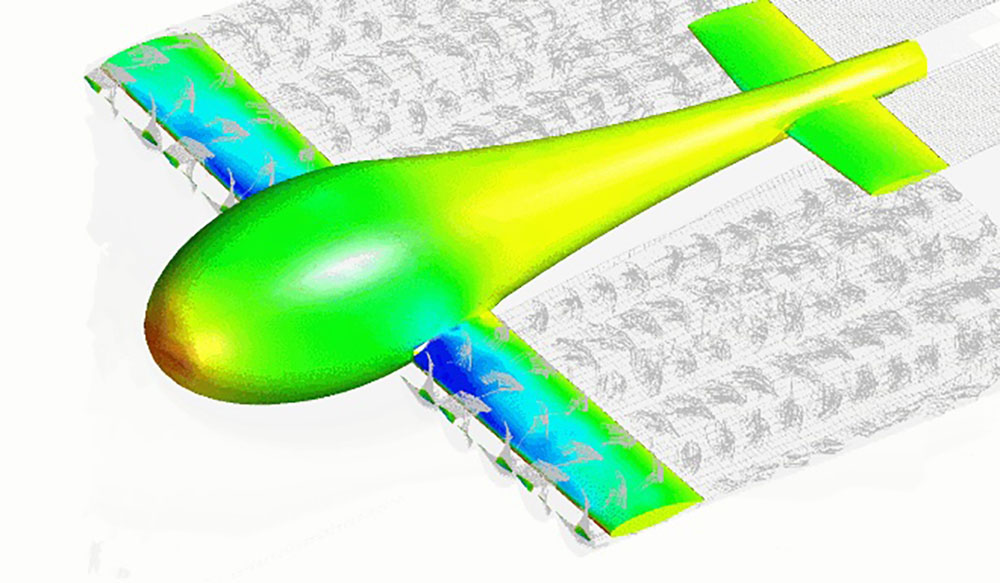Stay Up to Date
Submit your email address to receive the latest industry and Aerospace America news.
Initial modeling gives designers confidence before they turn to more expensive, higher-fidelity analysis
When Whisper Aero designed and built a small drone at its Tennessee facility to flight test its proprietary ducted-fan design, the goal was to identify as many potential aerodynamic problems — such as noise or dangerous structural loads — as early as possible.
Expensive wind tunnel testing and high-fidelity computational fluid dynamics modeling for the drone could come later to refine the design, but Whisper turned first to one of at least three relatively cheap software tools on the market that are targeted specifically toward aviation startups.
Whisper chose Research in Flight’s FlightStream, which visually shows designers how air flows around an aircraft and its propulsors, and does so with modest demands for computing power. Such tools are popular among startups for rapidly evolving a novel aircraft design in early stages, when investor dollars might be scarce and the concept is complex — for instance, designs that rely on distributed electric propulsion by six or more rotors.
FlightStream, for example, can be downloaded from the cloud and run on a laptop for the relatively quick calculations needed at these early design stages, Ian Villa, Whisper’s co-founder and chief operating officer, tells me. The company has been flying the drone now for two years.
Specifically, Whisper applied the software to the drone design to characterize “aerodynamics at various flight states before performing higher-fidelity computational fluid dynamics and integrating our propulsion more tightly,” Villa says. “It helps avoid any major pitfalls or wasting time on concepts that don’t carry weight.”
Research in Flight makes no guarantees about the success of an aircraft design based solely on FlightStream. “Once you get through the early design stage, it is important to validate the resulting design with high-fidelity tools to ensure that the proposed design is indeed true to its claims,” Vivek Ahuja, co-founder and CEO of the six-person company in Alabama, tells me in an interview. He notes that FlightStream can make predictions within 5% to 10% of the fidelity achieved by those other tools.
Other FlightStream users include the U.S. Department of Defense, which has contracted Research in Flight to study additional possible uses for the software, such as early prediction of hypersonic aerodynamics.
Also in the field, NASA has developed its free VSP tool, Vehicle Sketch Pad, for low-fidelity aerodynamic prediction. And California company Advanced Rotorcraft Technologies, ART, has a similar low- to moderate-fidelity tool, Flightlab, that can make such models and predictions. VSP, Flightlab and FlightStream can predict drag, stability, structural integrity and noise. While FlightStream and VSP require relatively little computing power, ART’s Flightlab requires a high-end Linux PC.
In comparison, for higher-fidelity predictions, “NASA would run parallel supercomputers for several days, which is very expensive,” says Nhan Nguyen, a senior research scientist at the agency’s Ames Research Center in Silicon Valley.
Some NASA researchers use FlightStream, but Nguyen says “VSP has a broad user base.” Like FlightStream, VSP is less accurate than high-fidelity computational fluid dynamics analysis, but “takes far less time, so the advantage is speed.”
Villa, the Whisper co-founder, says FlightStream is “modernizing aerodynamic prediction tools” that emerged from the outdated programming language FORTRAN, developed in 1957. Software with roots in FORTRAN does not include any graphics to interpret data. By contrast, FlightStream and VSP can produce multicolored images representing the aircraft and airflow around it without needing to export data into another program. If desired, data from the Flightlab software can also be exported to a graphic program.
FlightStream is based on aerodynamic prediction models made by panel methods, developed in the 1940s before computers crunched mathematical equations for such analysis, Ahuja says. At $3,800 per year for startups, a subscription to FlightStream is far less expensive than the more complex tools, he says.
Whereas Research in Flight sells just software, ART also sells consulting services, which means the company produces a computer model and some analysis for a client at a lower cost than purchasing its Flightlab software, says Jan Goericke, ART’s lead project engineer on rotorcraft and fixed-wing flight dynamic math model development. But the company doesn’t disclose pricing or names of clients.
He says Flightlab is especially suited to predicting flight dynamics and handling qualities in real-time simulations.
Startups designing electric aircraft are “very fast paced, and their focus can shift quickly. They drop in and out as clients frequently,” he says. “We have been working with quite a few of them.”
Get the latest news about advanced air mobility delivered to your inbox every two weeks.
About paul brinkmann
Paul covers advanced air mobility, space launches and more for our website and the quarterly magazine. Paul joined us in 2022 and is based near Kennedy Space Center in Florida. He previously covered aerospace for United Press International and the Orlando Sentinel.
Related Posts
Stay Up to Date
Submit your email address to receive the latest industry and Aerospace America news.




